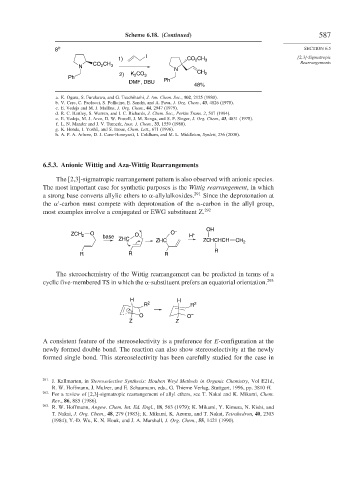Page 613 - Advanced Organic Chemistry Part B - Reactions & Synthesis
P. 613
Scheme 6.18. (Continued) 587
8 h SECTION 6.5
I [2,3]-Sigmatropic
1) CO 2 CH 3
CO CH Rearrangements
N 2 3
N CH
2) K 2 CO 3 2
Ph
DMF, DBU Ph
48%
a. K. Ogura, S. Furukawa, and G. Tsuchihashi, J. Am. Chem. Soc., 102, 2125 (1980).
b. V. Cere, C. Paolucci, S. Pollicino, E. Sandri, and A. Fava, J. Org. Chem., 43, 4826 (1978).
c. E. Vedejs and M. J. Mullins, J. Org. Chem., 44, 2947 (1979).
d. R. C. Hartley, S. Warren, and I. C. Richards, J. Chem. Soc., Perkin Trans. 2, 507 (1994).
e. E. Vedejs, M. J. Arco, D. W. Powell, J. M. Renga, and S. P. Singer, J. Org. Chem., 43, 4831 (1978).
f. L. N. Mander and J. V. Turnerk, Aust. J. Chem., 33, 1559 (1980).
g. K. Honda, I. Yoshii, and S. Inoue, Chem. Lett., 671 (1996).
h. A. P. A. Arbore, D. J. Cane-Honeysett, I. Coldham, and M. L. Middleton, Synlett, 236 (2000).
6.5.3. Anionic Wittig and Aza-Wittig Rearrangements
The [2,3]-sigmatropic rearrangement pattern is also observed with anionic species.
The most important case for synthetic purposes is the Wittig rearrangement, in which
a strong base converts allylic ethers to -allylalkoxides. 291 Since the deprotonation at
the -carbon must compete with deprotonation of the -carbon in the allyl group,
most examples involve a conjugated or EWG substituent Z. 292
ZCH 2 O O O – H + OH
base
ZHC _ ZHC ZCHCHCH CH 2
R
R R R
The stereochemistry of the Wittig rearrangement can be predicted in terms of a
cyclic five-membered TS in which the -substituent prefers an equatorial orientation. 293
H H
R 2 R 2
..
O O –
Z Z
A consistent feature of the stereoselectivity is a preference for E-configuration at the
newly formed double bond. The reaction can also show stereoselectivity at the newly
formed single bond. This stereoselectivity has been carefully studied for the case in
291
J. Kallmarten, in Stereoselective Synthesis: Houben Weyl Methods in Organic Chemistry, Vol E21d,
R. W. Hoffmann, J. Mulzer, and E. Schaumann, eds., G. Thieme Verlag, Stuttgart, 1996, pp. 3810 ff.
292 For a review of [2,3]-sigmatropic rearrangement of allyl ethers, see T. Nakai and K. Mikami, Chem.
Rev., 86, 885 (1986).
293
R. W. Hoffmann, Angew. Chem. Int. Ed. Engl., 18, 563 (1979); K. Mikami, Y. Kimura, N. Kishi, and
T. Nakai, J. Org. Chem., 48, 279 (1983); K. Mikami, K. Azuma, and T. Nakai, Tetrahedron, 40, 2303
(1984); Y.-D. Wu, K. N. Houk, and J. A. Marshall, J. Org. Chem., 55, 1421 (1990).

